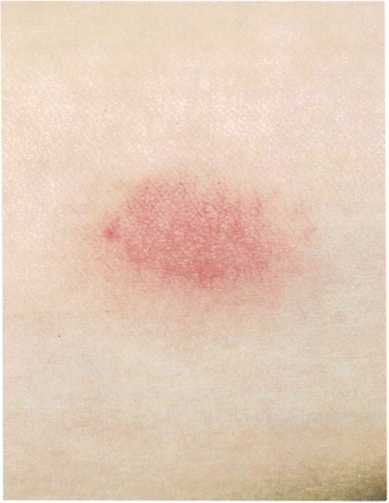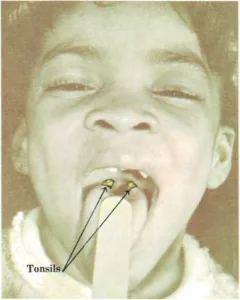Tonsilitis – Tuberculosis
Tonsillitis is an inflammation of the tonsils. The tonsils are
composed of lymphatic tissue and are located in small pockets on both
sides of the throat, behind the mouth.
Location of the tonsils

Tonsils grow on each side of the throat, in the back of the mouth.
Healthy tonsils help the body to fight infection.
Healthy tonsils help protect the body against infection.
During early childhood, most children have an average of four infections
of the upper respiratory tract each year. Each time, tonsillitis occurs.
Just how severe the tonsillitis is usually depends upon the kind of
virus or bacteria that causes it. Some cases of tonsillitis are so mild
that the child is bothered very little.
Most often, a child with tonsillitis complains of a sore throat and has
trouble swallowing. In severe attacks, the tonsils become quite swollen
and red. Patches of yellowish or grayish membrane may form on them.
Usually, the child has a fever and the lymph glands at the angles of the
jaws swell. Other signs of severe tonsillitis are headache and vomiting.
If the tonsillitis is caused by a bacteria sensitive to antibiotics, a
doctor may prescribe drugs. For example, the doctor may prescribe
penicillin for “strep tonsillitis,” to shorten the attack and to reduce
the possibility of complications such as nephritis or rheumatic fever.
Rarely, in severe attacks of tonsillitis, an abscess may develop in the
tissue around the tonsils. Or the tonsils may remain inflamed after
several attacks of tonsillitis, and the child may have a constant low
fever and constant swelling of the lymph glands in the neck. In such
extreme cases, the doctor may recommend a tonsillectomy. If the adenoids
are also constantly infected the doctor may remove them in the same
operation. Tonsillectomy is performed less often than it was many years
ago because the tonsils can be treated, and the indications for this
surgical procedure, which canries some risk, have become more
conservative, [m.g.]
See also Adenoids; Nephritis; Rheumatic fever; Swollen glands
Tourniquet. See Bites and stings; Bleeding
Tuberculosis is a serious contagious disease caused by tiny,
rod-shaped bacteria called tubercle bacilli. It usually develops in the
lungs, but it may appear in almost any part of the body.
The two main types of tuberculosis are commonly called primary infection
tuberculosis (when a person gets the disease for the first time) and
reinfection tuberculosis (when a person is infected a second, third, or
fourth time).
When a child develops a primary infection, the invading tubercle bacilli
are killed by white blood cells or walled up by cells and fibers that
prevent their spreading through the body. Usually, the child does not
feel ill or show any symptoms of the disease.
Reinfection tuberculosis may occur if the body’s resistance is low
because of illness, poor diet, or other causes. Then the tubercle
bacilli that have been walled up break out and multiply. They may spread
faster than they can be killed or walled up. A reinfected child usually
has a fever, loses weight, has a cough, and is weak. Primary infection
tuberculosis is more common among children who have not yet reached
adolescence. An adolescent is more likely to develop reinfection
tuberculosis.
If you suspect that your child has tuberculosis, or if you know that the
child has been

If the site of a tuberculin test shows significant redness and
swelling after two days, the test is positive.
exposed to it, contact your doctor immediately. With a doctor’s care, a
child with tuberculosis may be cured in a year or two.
A child with tuberculosis usually begins treatment in a hospital.
Eventually, the child may be treated at home. Doctors rely primarily on
drugs to cure tuberculosis, but surgery is sometimes called for.
The tuberculin test is a simple method of learning if a child is
infected with tubercle bacilli. The test may be made at 12 months, or at
15 months when the measles-mumps- rubella shot is given. A drop of
harmless tuberculin (liquid prepared from dead tubercle bacilli) is
injected, scratched, or rubbed into the child’s skin. If after two days
the spot becomes red and swollen, the test is considered positive. A
positive reaction means the child has been infected by tubercle bacilli
at some time. A test resulting in no reaction indicates that the child
has never been infected by tubercle bacilli. A child who has a positive
reaction should have a chest X ray to determine if the disease is
active. The doctor may also order other tests and X rays of other parts
of the body.
Adults who have been in contact with the child also should have chest X
rays to determine who infected the child. Almost all cases of
tuberculosis in infants and young children are contracted from someone
in the child’s household. Other people in the household should have
tuberculin tests to determine if they have been infected, too.
Some children who live in areas where tuberculosis is prevalent, and
children in a family with an active case, may be immunized against
primary infection by drugs or shots of BCG (Bacillus Calmette-Guerin)
vaccine, [h.d.r..] jr.
Tumor. See Cancer
Twitch. See Chorea; Tic

